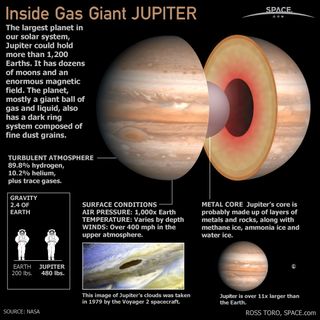What is Jupiter made of?
Composed predominantly of hydrogen and helium, the massive Jupiter is much like a tiny star. But despite the fact that it is the largest planet in the solar system, the gas giant just doesn't have the mass needed to push it into stellar status.
The surface of Jupiter
When scientists call Jupiter a gas giant, they aren't exaggerating. If you parachuted into Jupiter in hopes of hitting the ground, you would never find firm landing. The atmosphere of Jupiter is 90 percent hydrogen. The remaining 10 percent is almost completely made up of helium, though there are small traces of other gases inside.
These gases pile on top of one another, forming layers that extend downward. Because there is no solid ground, the surface of Jupiter is defined as the point where the atmospheric pressure is equal to that of Earth. At this point, the pull of gravity is almost two and a half times stronger than it is on our planet.
Trying to stand on that surface would be impossible, since it is simply another layer of gases. Spacecraft and astronauts would only sink into the mire. A probe or spacecraft traveling farther toward the center of the planet would continue to find only thick clouds until it reached the core.
Jupiter's core
Details about Jupiter's core remain a challenge to find. Scientists think that the dense central core may be surrounded by a layer of metallic hydrogen, with another layer of molecular hydrogen on top.
Scientists aren't certain of just how solid Jupiter's core might be. While some theorize that the core is a hot molten ball of liquid, other research indicates that it could be a solid rock 14 to 18 times the mass of the Earth. The temperature at the core is estimated to be about 35,000 degrees Celsius (63,000 degrees Fahrenheit).
Discussions about Jupiter's core didn't even begin until the late 1990s, when gravitational measurements revealed that the center of the gas giant was anywhere from 12 to 45 times the mass of Earth. And just because it had a core in the past doesn't mean that it still will today – new evidence suggests that the gas giant's core may be melting.
Not quite a star
Like the sun, Jupiter is composed predominantly of hydrogen and helium. But unlike the sun, it lacks the necessary amount to begin fusion, the process that fuels a star. Jupiter would need to be 75 to 80 times more massive than it is at present to be considered a star. If all of the planets in the solar system had formed as part of the gas giant, it still would not have sufficient mass. Still, by itself, Jupiter is two and a half times larger than all of the other planets in the solar system combined.
— Nola Taylor Redd, SPACE.com Contributor

Related:
Join our Space Forums to keep talking space on the latest missions, night sky and more! And if you have a news tip, correction or comment, let us know at: community@space.com.
Get the Space.com Newsletter
Breaking space news, the latest updates on rocket launches, skywatching events and more!

Nola Taylor Tillman is a contributing writer for Space.com. She loves all things space and astronomy-related, and enjoys the opportunity to learn more. She has a Bachelor’s degree in English and Astrophysics from Agnes Scott college and served as an intern at Sky & Telescope magazine. In her free time, she homeschools her four children. Follow her on Twitter at @NolaTRedd
